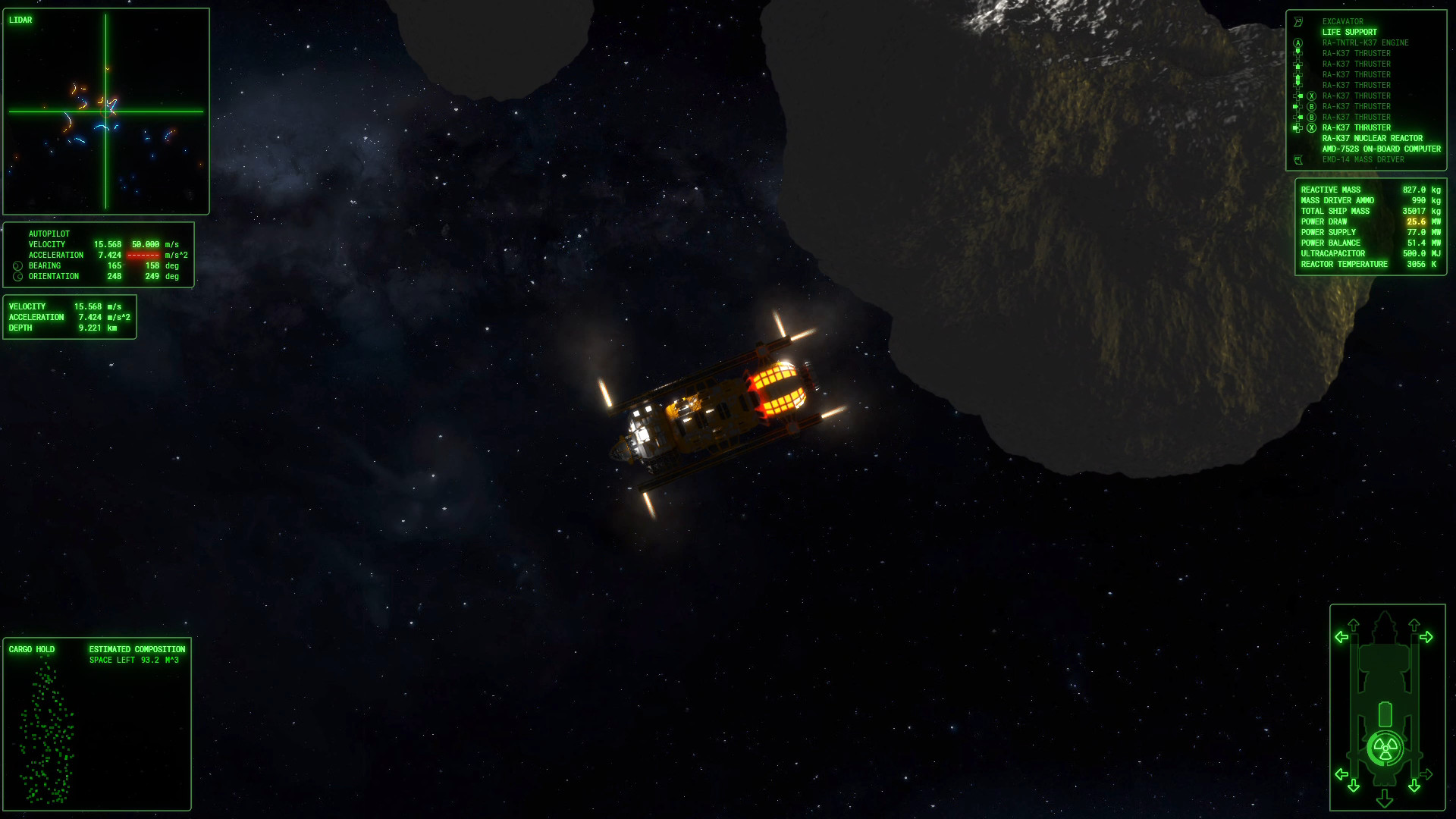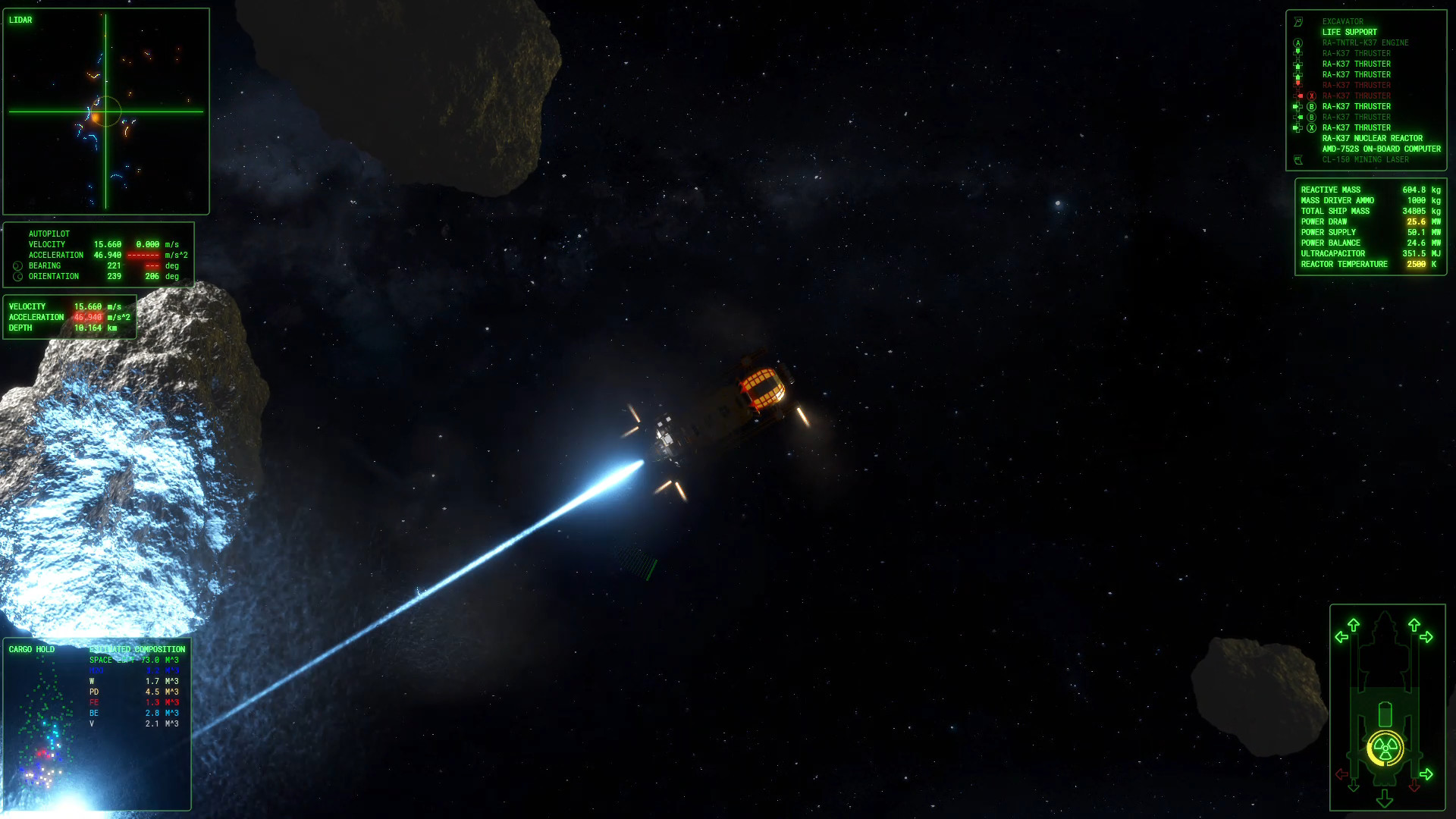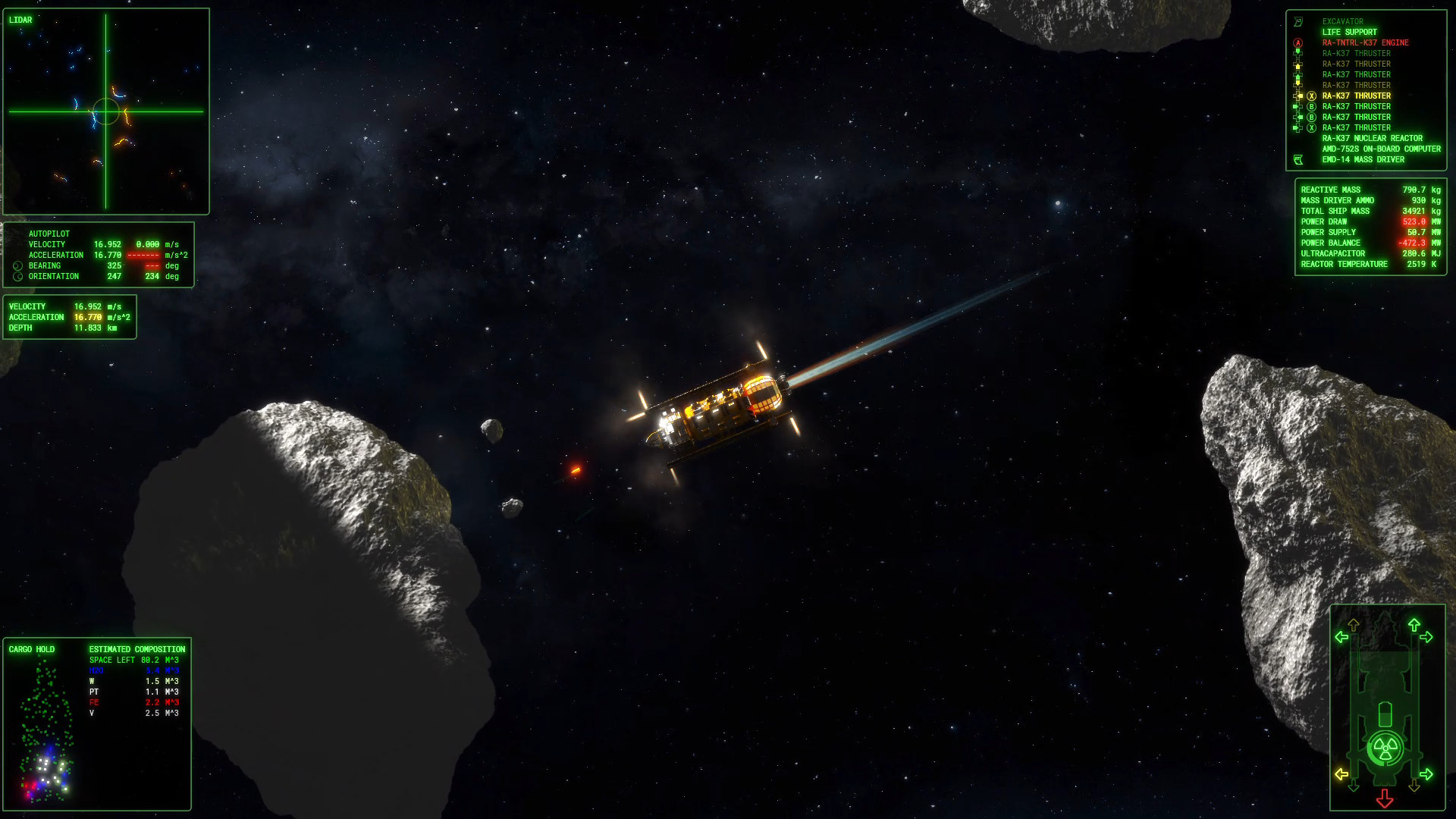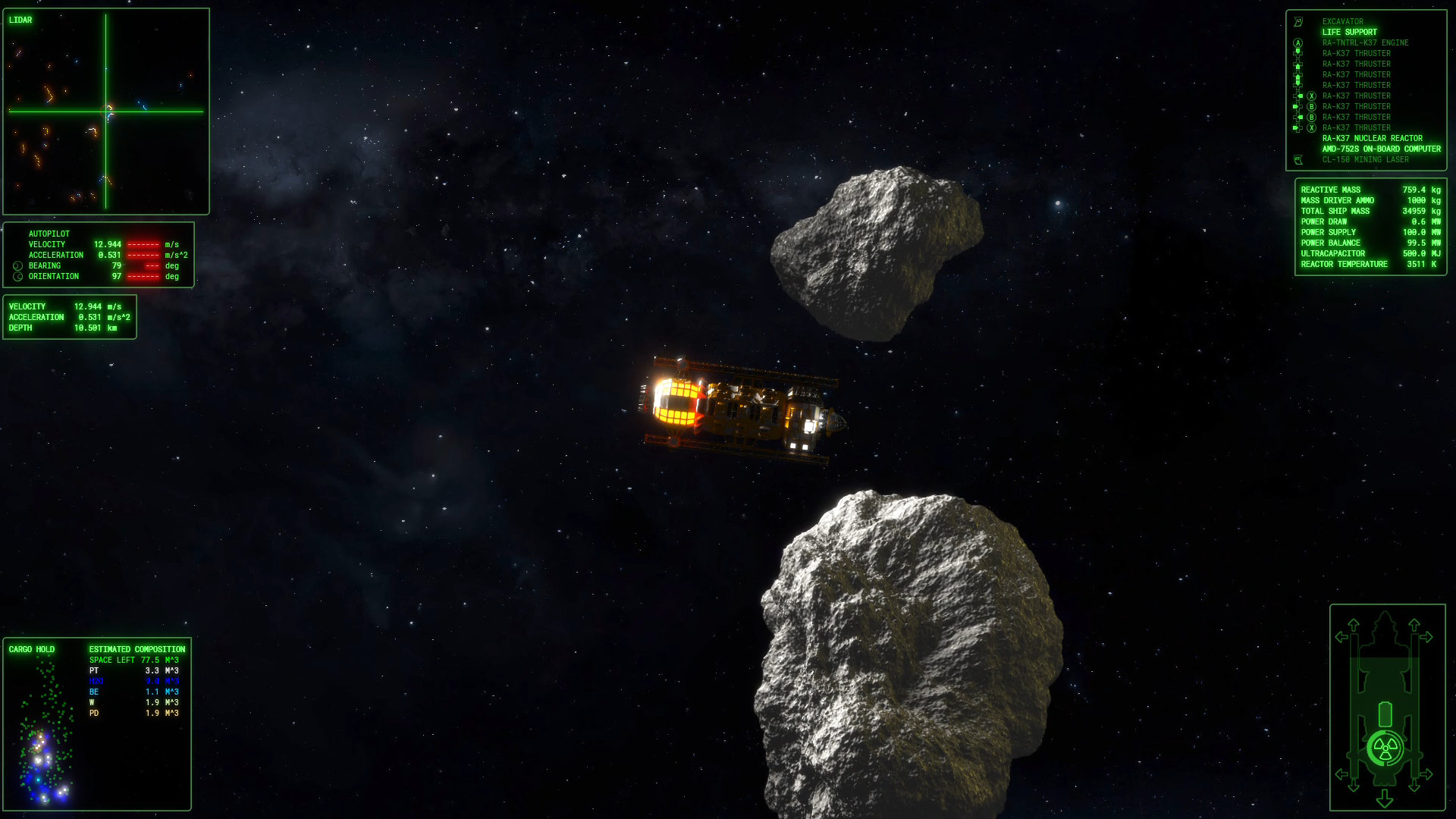The year is 2273
The unexpected discovery of valuable minerals within the rings of Saturn has sparked a thriving space excavation industry. You control an asteroid excavation ship hoping to make it rich out on the rings, but soon you find out that all is not as it appears. Experience a hard sci-fi story backed up with real physics and science.Key Features
- Realistic top-down hard sci-fi space flight experience. Every aspect of gameplay is backed up by real science. Ships fly just as starships should.
- Jump into action in seconds with autopilot assist or save fuel by manual thruster maneuvers.
- Detailed ship simulation down to every subsystem - upgrade your ship, fix or even jury-rig broken systems on the fly. Every system failure will impact gameplay - adapt to survive in the hostile environment of space.
- Discover the mystery of the Rings, or just try to get rich leading your excavation company.
- Plan your strategy back on Enceladus Prime station. Sell your output, upgrade your ship, hire the crew and manage your company.
1.37.2 - Stable Orbit



EPAA discovers new moonlets
In a groundbreaking development, during a routine mineral survey, the Enceladian Polar Astronomical Array (EPAA) detected new, previously undiscovered moonlets located in the plane of Saturn's Rings. What sets these celestial bodies apart is their unique characteristic: unlike their predecessors, these moonlets do not form the typical propeller formations observed in planetary rings. This discovery defies the current understanding and theories of moonlet formation and its behavior within the dense and dynamic environment of planetary rings. EPAA has announced plans for an on-site examination slated for later this month.
New autopilot software regulations
A critical announcement issued today by the Enceladian Space Regulatory Commission unveiled comprehensive new regulations, mandating that all spacecraft autopilot systems must be enhanced to include precise tracking of surfaces of larger asteroids and moonlets. This regulatory overhaul has ignited controversy, as there are growing concerns that Elon Interstellar, a frontrunner in autopilot technology with pre-existing surface tracking capabilities, may have influenced the push for these updated standards. Critics contend that this move unfairly benefits the Martian-based conglomerate, triggering a heated debate over the equity of the new regulations.
Mineral discharge terminal upgraded
In response to the unprecedented boom in mining activities within the Rings, the Enceladus Prime ore unloading facility has recently completed a series of significant upgrades to enhance its operational capacity. Having reached their operational thresholds, the previously utilized Armstrong-TX7500 unloading arms contributed to considerable delays, resulting in lengthy queues of mining ships awaiting their turn to offload their valuable yields. The facility has integrated the cutting-edge Tetsuo-series electromagnetic delivery system into its unloading infrastructure to address this bottleneck. This state-of-the-art upgrade is set to revolutionize the station's processing capabilities, promising an astounding increase in throughput efficiency by over 9000%.
Maintenance logs
- Added a new moonlet story event to encounter.
- Enhanced autopilot targeting. You can now target a specific spot on the surface of a large object, like a moonlet, and autopilot will align to that spot. This prevents accidents where you click on a wall of a cave you were traversing to have the autopilot spin your ship toward the center of mass of the moonlet, wrecking your thrusters in the process. Now, it will instead point your ship towards the part of the wall you clicked on, wrecking your thrusters in the process.
- When you are scrapping your ship paint along a rocky surface, it will not sound like multiple impacts anymore.
- Improved performance of ship-mounted spotlights. This will be most noticeable on integrated GPUs.
- Improved adrenaline collision detection performance. This lowers the CPU requirement all around.
- Improved pathfinding for entities that rarely move, such as space stations. This lowers CPU requirements near such objects.
- Entities that cannot move at all will not imagine the paths they could take if they suddenly gain the ability to move. Such electric dreams wasted CPU cycles. They will now dream about android sheep instead.
- You can't salvage traveling phage stations anymore. They have their jobs, and they intend to fulfill them.
- A quirk in the spawning routines could cause many more rocks to spawn near entities that should not contain rocks inside. This artificially increased the density of asteroids around stations and moonlets and caused waves of asteroids to decrease game performance.
- Updated radiation shaders to work with ships that are hidden in caves.
- Your astrogator will need to have a way to detect a ship before he can trace it with the tactical marker. This means that they will not mark ships hiding inside caves anymore and can slow down ship identification in dense areas, like propeller formations or around moonlets.
- Improved the layout of the dive summary screen. Ores will now be spaced out equally, with unusual finds closer to the center of the screen.
- Optimized dive summary screen so that it won't be bogged down - or crash - if you bring hundreds of chunks of raw ore back.
- Added extra lights and adjusted a number of shadow settings for the brand-new moonlet event.
- Fixed two of the POI events not linking correctly, which caused you to rediscover a plain "moonlet" while you already knew about the secret inside.
- Pulse thrusters and torches that ran out of reaction mass during operation continued to burn as long as the control was held, draining the negative mass out of the universe and upsetting the dark matter/energy balance.
- The dealership was raising the price of the ships with kinetic and nanodrone systems by more than the system was worth, upsetting the economy somewhat.
- Ship plumes from RCS discharge inside moonlets will not be visible on the visual feed.
- You cannot astrogate from inside of a moonlet anymore.
- If your autopilot velocity limit was set to a number that was not a multiple of ten, the velocity slider on the in-dive Astrogation tab could not be set all the way to the top.
- Changed the way docking arms forcefully undock your ship. They are now aware of the ship's orientation or station you are docked to and will eject you away from that ship instead of just moving you the closest way outside the designated docking spot.
- Big Bad Wolf will now always stop completely after docking with you.
- Changed the physics settings of the External Impact Absorbers. They are now softer, dealing less damage in kinetic collisions, and their collision resolution uses a continuous collision detection algorithm - which should prevent physics glitches when impacting megaton asteroids at high speeds but does decrease the physics performance a bit.
- Updated translations.
[ 2024-03-03 19:56:13 CET ] [Original Post]
Minimum Setup
- OS: 64 bit
- Processor: i3 2.4GHz or equivalentMemory: 4 GB RAM
- Memory: 4 GB RAM
- Graphics: Intel UHD 730 2GB VRAM or equivalent
- Storage: 2 GB available spaceAdditional Notes: Try running the demo to verify if your system can handle it
GAMEBILLET
[ 6359 ]
GAMERSGATE
[ 3675 ]
MacGamestore
[ 2899 ]
FANATICAL BUNDLES
HUMBLE BUNDLES
by buying games/dlcs from affiliate links you are supporting tuxDB
















































